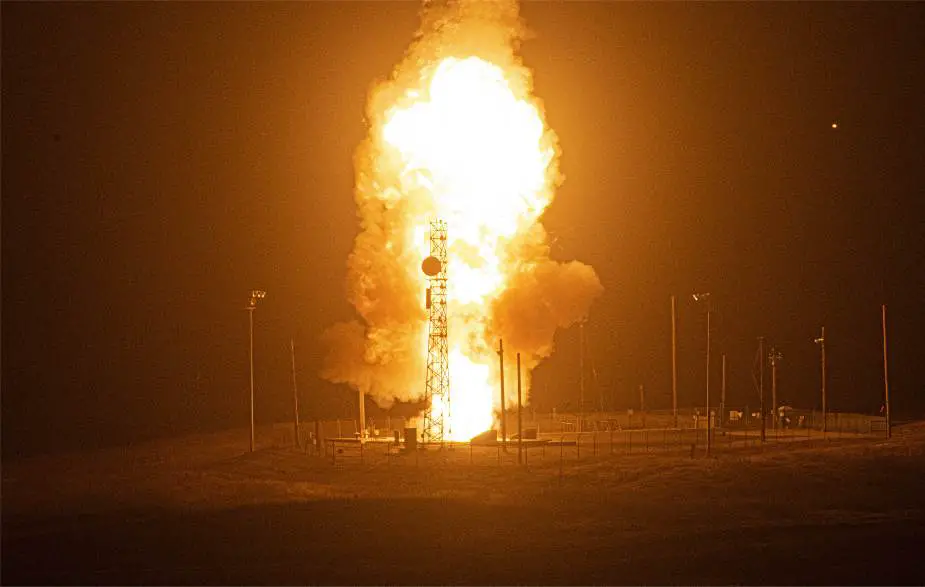Breaking news
United States has test launched Minuteman III ICBM ballistic missile.
According to information published by the U.S. Strategic Command on August 4, 2020, A joint team of United States Air Force Global Strike Command Airmen and Navy sailors launched an unarmed Minuteman III intercontinental ballistic missile equipped with three test reentry vehicles from aboard the Airborne Launch Control System at 12:21 a.m. Pacific Time Aug. 4 from Vandenberg Air Force Base, California.
Follow Army Recognition on Google News at this link

An Air Force Global Strike Command unarmed Minuteman III intercontinental ballistic missile launches during an operational test at 12:21 a.m. Pacific Daylight Time 4 August 2020, at Vandenberg Air Force Base, Calif. (Picture source U.S. Strategic Command)
The test demonstrates that the United States’ nuclear deterrent is safe, secure, reliable and effective to deter twenty-first century threats and reassure our allies. Test launches are not a response or reaction to world events or regional tensions.
Airmen from the 625th Strategic Operations Squadron out of Offutt Air Force Base, Nebraska, were aboard the U.S. Navy E-6 aircraft to demonstrate the reliability and effectiveness of the ALCS system.
The ICBM's three reentry vehicles traveled approximately 4,200 miles to the Kwajalein Atoll in the Marshall Islands. These test launches verify the accuracy and reliability of the ICBM weapon system, providing valuable data to ensure a continued safe, secure and effective nuclear deterrent.
The ICBM community, including the Department of Defense, the Department of Energy, and U.S. Strategic Command uses data collected from test launches for continuing force development evaluation. The ICBM test launch program demonstrates the operational capability of the Minuteman III and ensures the United States’ ability to maintain a strong, credible nuclear deterrent as a key element of U.S. national security and the security of U.S. allies and partners.
The launch calendars are built three to five years in advance, and planning for each individual launch begins six months to a year prior to launch. This launch is not related to any events in the world at this time.
Air Force Global Strike Command is comprised of more than 33,700 Airmen and civilians assigned to two numbered air forces, 11 wings, two geographically-separated squadrons and one detachment in the continental United States, and deployed to locations around the globe. The command overseas all bomber and Intercontinental Ballistic Missile operations for the U.S. Department of Defense.
The Minuteman Weapon System was conceived in the late 1950s, and developed and deployed in the 1960s. The system was designed to deter any aggressor, but if deterrence failed, to be able to withstand an attack and provide instant retaliation capability. At the time of its conception, Minuteman represented a new dimension in weaponry. Widely dispersing missiles in nuclear-hardened launchers was a novel idea that was developed into the present Minuteman Weapon System by the Ballistic Missile Organization of the Air Force Systems Command (AFSC). Today, engineering and maintenance of Minuteman is managed by the Intercontinental Ballistic Missile (ICBM) System Program Office (SPO) at the Ogden Air Logistics Center (OO-ALC) under Air Force Materiel Command (AFMC).
The first generation of Minuteman, the Minuteman I (LGM-30A and B), was a highly reliable, three-stage, solid propellant missile, capable of withstanding storage in an alert “ready” condition for long periods of time. Minuteman I ground systems were designated WS-133A, and missiles were installed in underground launchers located at unmanned sites. Each missile was capable of being launched, even after being subjected to overpressure from a nuclear blast, with a range of over 5,000 nautical miles and a continuously operating guidance set.
The basic characteristics of the WS-133 weapon system have not changed since Minuteman I missiles were deployed. However, advances in technology and changes in national policy induced improvements in the original design. The 800 Minuteman I missiles which stood guard over 20 years ago were replaced by the more capable Minuteman II (LGM-30F) and later, by the Minuteman III (LGM-30G) missiles, shown below. The ground systems, which house and support the missiles, have also been made more survivable, efficient, and secure over the years. In June 1992, the Air Force began retiring Minuteman II so that the LGM-30G missile was the only version of Minuteman fielded by 1995.

























